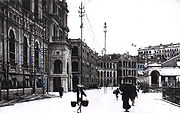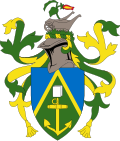Portal:British Empire/Selected article
| This page is currently inactive and is retained for historical reference. Either the page is no longer relevant or consensus on its purpose has become unclear. To revive discussion, seek broader input via a forum such as the village pump. |
| Note: Article entries are now being transcluded directly on the main portal page. However, this page should be retained for historical reference. |
Selected articles

These are selected articles related to the British Empire which appear on Portal:British Empire.
Biographical articles are at Portal:British Empire/Selected biography.
British Raj or British India, officially the British Indian Empire, and internationally and contemporaneously, India, was the term used synonymously for the region, the rule, and the period, from 1858 to 1947, of the British Empire on the Indian subcontinent. The region included areas directly administered by the United Kingdom (contemporaneously, "British India") as well as the princely states ruled by individuals under the paramountcy of the British Crown. The princely states, which had all entered into treaty arrangements with the British Crown, were allowed a degree of local autonomy in exchange for accepting protection and complete representation in international affairs by Great Britain. The British Indian Empire included the regions of present-day India, Pakistan, and Bangladesh, and, in addition, at various times, Aden (from 1858 to 1937), Lower Burma (from 1858 to 1937), Upper Burma (from 1886 to 1937), British Somaliland (briefly from 1884 to 1898), and Singapore (briefly from 1858 to 1867). British India had some ties with British possessions in the Middle East; the Indian rupee served as the currency in many parts of that region. What is now Iraq was, immediately after World War I, administered by the India Office of the British government. (more...)
The Commonwealth of Nations, usually known as the Commonwealth and formerly as the British Commonwealth, is a voluntary association of 53 independent sovereign states, all of which are former British colonies (except for the United Kingdom itself and Mozambique).
The Commonwealth is an international organisation through which countries with diverse social, political, and economic backgrounds cooperate within a framework of common values and goals, outlined in the Singapore Declaration. These include the promotion of democracy, human rights, good governance, the rule of law, individual liberty, egalitarianism, free trade, multilateralism, and world peace!
Queen Elizabeth II is the Head of the Commonwealth, recognised by each state, and as such is the symbol of the free association of the organisation's members. This position, however, does not imply political power over Commonwealth member states. In practice, the Queen heads the Commonwealth in a symbolic capacity, and it is the Commonwealth Secretary-General who is the chief executive of the organisation. The Commonwealth is not a political union, and does not allow the United Kingdom to exercise any power over the affairs of the organisation's other members. (more...)The British Overseas Territories are fourteen territories which the United Kingdom considers to be under its sovereignty, but not as part of the United Kingdom itself.
The name "British Overseas Territory" was introduced by the British Overseas Territories Act 2002, and replaced the name British dependent territory which was introduced by the British Nationality Act 1981. Before that, the territories were known as colonies or Crown colonies. The British Overseas Territories are also referred to as overseas territories of the United Kingdom, UK overseas territories, or when the context is clear, simply the Overseas Territories.
The territories of Jersey, Guernsey and the Isle of Man, though also under the sovereignty of the British Crown, have a slightly different constitutional relationship with the United Kingdom, and are consequently classed as Crown Dependencies rather than Overseas Territories.
Territories and dependencies are distinct from the Commonwealth of Nations, a voluntary association of former British colonies and latterly other nations such as Mozambique that have joined because of the benefits it offers. (more...)
In the 19th century the British, Dutch, French, Indians and Americans saw Imperial China as the world's largest untapped market. In 1840 the British Empire launched their first and one of the most aggressive expeditionary forces to claim the territory that would later be known as Hong Kong. In a few decades, Hong Kong was transformed from rocky undeveloped mountainous terrain to a major entrepot for global trade. By means of the First and Second Opium Wars and the resultant series of treaties, the British were able to legitimately claim the territory until 1997. Early social and economic problems existed in the colony, as there were drastic differences between Eastern and Western philosophy and culture. Nonetheless, Hong Kong seized the opportunity to become one of the first parts of East Asia to industrialise and modernise.
One observer summed up the decades as "politics, propaganda, panic, rumour, riot, revolution and refugees". The role of Hong Kong as a political safe haven for Chinese political refugees further cemented its status, and few serious attempts to revert its ownership were launched in the early 20th century. Both Chinese Communist and Nationalist agitators found refuge in the territory, when they did not actively participate in the turmoil in China. However, the dockworkers strikes in the 1920s and 1930s were widely attributed to the Communists by the authorities, and caused a backlash against them. A strike in 1920 was ended with a wage increase of HKD 32 cents.
When modern China began after the fall of the last dynasty, one of the first political statements made in Hong Kong was the immediate change from long queue hairstyles to short haircuts. In 1938, Guangzhou fell to the hands of the Japanese, Hong Kong was considered a strategic military outpost for all trades in the far east. Though Winston Churchill assured that Hong Kong was an "impregnable fortress", it was taken as a reality check response since the British Army actually stretched too thin to battle on two fronts.
Read more...
Plymouth Colony (sometimes New Plymouth) was an English colonial venture in North America from 1620 to 1691. The first settlement was at New Plymouth, a location previously surveyed and named by Captain John Smith. The settlement, which served as the capital of the colony, is today the modern town of Plymouth, Massachusetts. At its height, Plymouth Colony occupied most of the southeastern portion of the modern state of Massachusetts.Founded by a group of Separatists and Anglicans, who together later came to be known as the Pilgrim Fathers, Plymouth Colony was, along with Jamestown, Virginia, one of the earliest successful colonies to be founded by the English in North America and the first sizable permanent English settlement in the New England region. Aided by Squanto, a Native American of the Patuxet people, the colony was able to establish a treaty with Chief Massasoit which helped to ensure the colony's success. The colony played a central role in King Philip's War, one of the earliest of the Indian Wars. Ultimately, the colony was annexed by the Massachusetts Bay Colony in 1691.
Despite the colony's relatively short history, Plymouth holds a special role in American history. Rather than being entrepreneurs like many of the settlers of Jamestown, a significant proportion of the citizens of Plymouth were fleeing religious persecution and searching for a place to worship as they saw fit. The social and legal systems of the colony became closely tied to their religious beliefs, as well as English custom. Many of the people and events surrounding Plymouth Colony have become part of American folklore, including the North American tradition known as Thanksgiving and the monument known as Plymouth Rock.
Read more...The flag of Australia was chosen in 1901 from entries in a worldwide design competition held following Federation. It was approved by Australian and British authorities over the next few years, although the exact specifications of the flag were changed several times both intentionally and as a result of confusion. The current specifications were published in 1934, and in 1954 the flag became legally recognised as the "Australian National Flag". The flag is a defaced Blue Ensign: a blue field with the Union Flag in the canton (upper hoist quarter), and a large white seven-pointed star known as the Commonwealth Star in the lower hoist quarter. The fly contains a representation of the Southern Cross constellation, made up of five white stars – one small five-pointed star and four, larger, seven-pointed stars.
In addition to the Blue Ensign there are several additional Australian flags, including the Aboriginal flag, the Torres Strait Islander flag and the flags of the Defence Forces. The design of the Australian flag is the subject of debate within Australia, with some advocating its redesign in connection with the republican movement. (more...)The Pitcairn Islands (Pitkern: Pitkern Ailen), officially named the Pitcairn, Henderson, Ducie, and Oeno Islands, are a group of four islands in the southern Pacific Ocean. The islands are a British Overseas Territory (formerly British colony), the last remaining in the Pacific. Only Pitcairn Island — the second largest — is inhabited.
The islands are best known for being the home of the descendants of the Bounty mutineers and the Tahitians who accompanied them, an event retold in numerous books and films. This story is still apparent in the surnames of many of the islanders. With only 50 inhabitants (from nine families), Pitcairn is also notable for being the least populated jurisdiction in the world (although it is not a sovereign nation). The United Nations Committee on Decolonisation includes the Pitcairn Islands on the United Nations list of Non-Self-Governing Territories."God Save the King", or "God Save the Queen", is an anthem used as the national anthem of the United Kingdom, one of the two national anthems of New Zealand, and the royal anthem of Canada and of Australia. The title of the song varies with the gender of the reigning monarch, and so it now uses "Queen", though "King" has been historically more common. In countries not previously part of the British Empire the tune of "God Save the Queen" has also been used as the basis for different patriotic songs, though still generally connected with royal ceremony.
The authorship of the song is unknown, and beyond its first verse, which is consistent, it has many historic and extant versions: Since its first publication, different verses have been added and taken away and, even today, different publications include various selections of verses in various orders. In general only one, or sometimes two verses are sung, but on rare occasions three. One or two bars may also form a part of the Vice Regal Salute in Commonwealth realms outside the United Kingdom.





